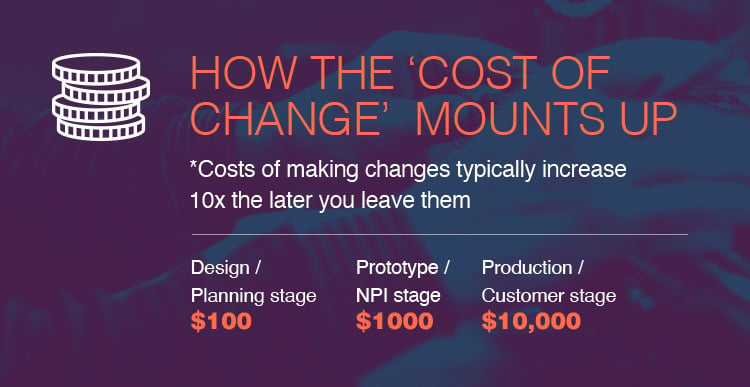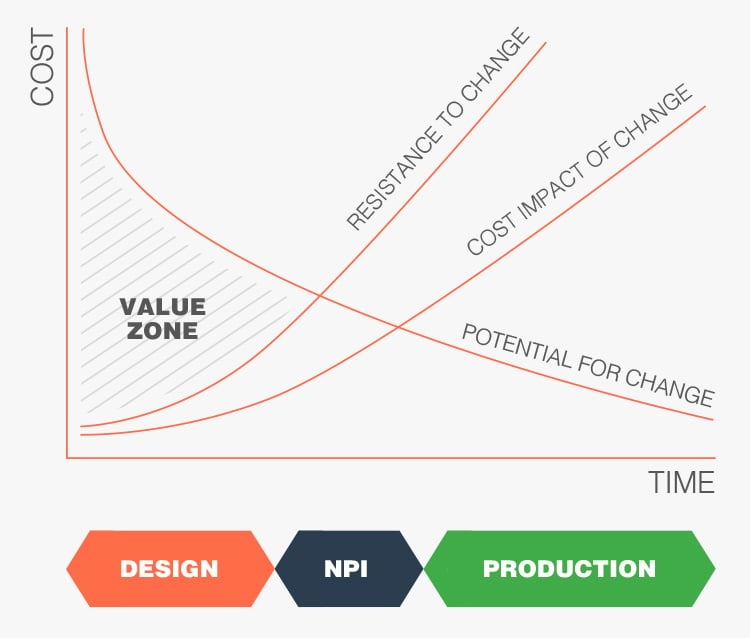Products can be ’value engineered’ during any of the three stages of the classic product life cycle. You can usefully apply VA/VE techniques to reduce costs and increase the value of your product during the design process, the NPI stage or the production phase (post-launch). But what are the pros and cons of each approach?
When will Value Engineering have the most impact?
1.During the design phase?
Around 80% of a products’ final cost is fixed during the design stage so it makes sense to focus on optimising its value at this point rather than later on, when making changes will be more costly and disruptive.
Pros
- In the design phase engineers are often not considering the harsh realities of supply chains and the final cost of BOMs. They are focused on designing powerful functionality and seamless user experiences, but they may be less interested in specifying the most cost effective materials, refining plans for ease of assembly or thinking about delivery logistics for the final product . A major advantage of the cross functional VA/VE approach is that it can factor all these considerations into your design thinking with expertise from different department, to optimise the product before it is prototyped and transferred to a manufacturer.
- Resistance towards making changes at this stage will be minimal because the product design is still evolving. The development team will have creative licence to explore ideas with the other stakeholders without too many preconceived boundaries. VA/VA can become an integral part of your creative as well as your commercial process.
- The cost implications of making changes to the design at this stage are relatively low because they are quicker and easier to do, and have no real impact to other departments There are no ECN (engineering change orders) or other administrative tasks required to make a change happen.
- VA/VE is an excellent way of eliminating extraneous functionality and unnecessary costs from your design, BOMs and build process, before they have become ‘baked in’ and integral to the way you do things.
Cons:
- Applying a thoroughgoing VA/VE process during your design phase will inevitably elongate your TTM (time to market) which will increase your costs and may threaten your ability to ‘steal a march’ on your competitors.
- Establishing all the elements of a cross functional VA/VE process will require considerable effort to set up. Your business should be prepared to give the necessary time and support for the investigation, function analysis and post launch tracking of results if your Value Engineering process is going to deliver and demonstrate ROI. This can be quite a challenge for businesses with limited time and staff resources to spare.
2. During the NPI Stage ?
Many of the advantages of doing VA/VE during the design phase apply here. You will be identifying key ways to optimise your product and production process early on, before they become they ‘fixed in stone’ and more costly to change
Pros
- Sometimes you just can’t predict how a design will behave in the ‘real world’, when it’s in the hands of a user. Waiting to Value Engineer a product until you’re in the NPI and prototyping stage provides the mechanism for picking up on performance issues which couldn’t be foreseen, or fully thought through when the product was just a set of drawings and specifications.
- Design for manufacture (DFm) and other DFx initiatives can now be put into practice, with processes tested and tweaked as you deal with the physical and functional aspects of the product.
Cons:
- Resistance to change will now start to increase due to time and cost implications associated with changing the design. VA/VE will naturally consume more of the development teams’ time when they could be focusing on the next project and revenue stream. Is that a compromise you are prepared to make?
- At this stage, the potential for change also starts to decrease as the design will now be almost fully committed to certain functionality, design features, test and tooling. In addition to this, material savings will be harder to identify because the supply chain has not yet had the opportunity to stabilise and reach maturity.
3. During the production stage
Waiting until the product has had time to prove itself on the market before you conduct the VA/VE process will give you lots of insight and data to support your re-engineering decision making. But it can also mean that you’ve launched the most costly version of your product onto the market and impacted potential profitability from the get-go.
Pros:
- Conducting a full VE analysis at this stage allows you to look at the product from a holistic viewpoint. It enables you to identify what you would have done differently and make re-engineering choices based on hard data.
- Post launch VA/VA allows you to conduct analysis of quality metrics and identify the real pain points of customers – all of which will have costs (often hidden) attached to them.
- Because the supply chain is now mature you can more fully understand what materials and processes are playing a part in driving the real cost of your product.
- VE analysis at this stage is a golden opportunity to consider longer term, more strategic initiatives like platform design strategy (modular design) to help reduce time to market (TTM).
- It’s also an opportunity to explore new and emerging technologies to incorporate into the next generation of your product range.
Cons:
- Full VE analysis requires a dedicated cross functional team, time and effort to conduct properly. It can be an expensive exercise.
- If the VA/VE process is being driven by procurement alone, it’s possible you could end up concentrating on simple cost cutting measures rather than the full array of reengineering possibilities to improve functionality and value for the consumer. It can limit you to cost efficiencies gained through lean manufacturing practices, material pricing and supply chain optimisation. If you do this, you will only be looking at a small part of the bigger picture - rather than the opportunity to experiment with new materials, meet customer needs differently or reassess the products’ future altogether.
- The later you leave your VA/VE process the more ingrained inefficiencies will be in the way you do things - and the more difficult those unnecessary and costly practices will be to identify, disentangle and reengineer.
- The rule of 10 applies here. In other words, the later changes are made in the product cycle, costs typically increase by a factor of 10.

- Resistance to change will now be at its highest point because the potential costs and disruption associated with implementing changes at this late stage could be significant. The product owner must now seriously consider the potential ROI payback versus the money that can be made from the product during its remaining life span.
Conclusion
Delaying a VA/VE process until several years into the lifespan of a new electronics product may prevent you from realising its full commercial potential altogether, particularly as turnover of new products in the market is so rapid. In your rush to get to market and in the current fast moving and volatile commercial conditions, you may miss, forever, opportunities to optimise supply chains and find more profitable ways of delivering on a products' potential. Establishing a VA/VE process that can be applied at the beginning of a products' lifecycle can ensure each product you design is set up for maximum profitability from the outset. But finding the people, structure and discipline to deliver this over and over again is a new and real challenge for OEMs who need to keep their competitive edge.


